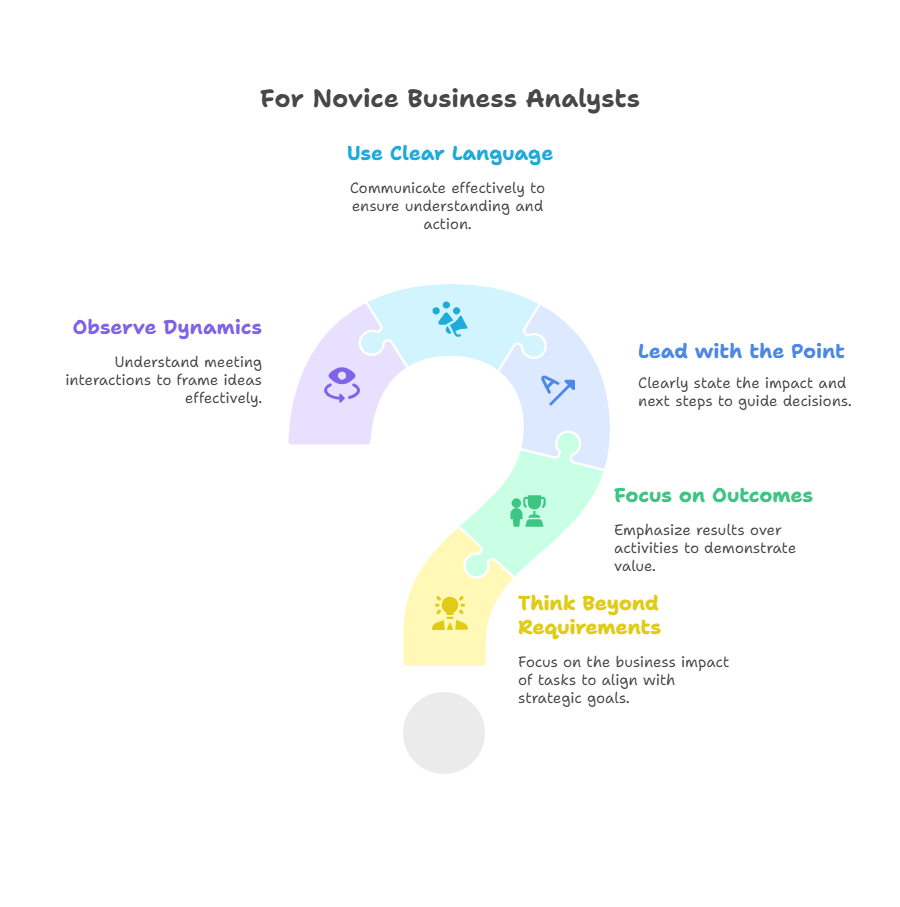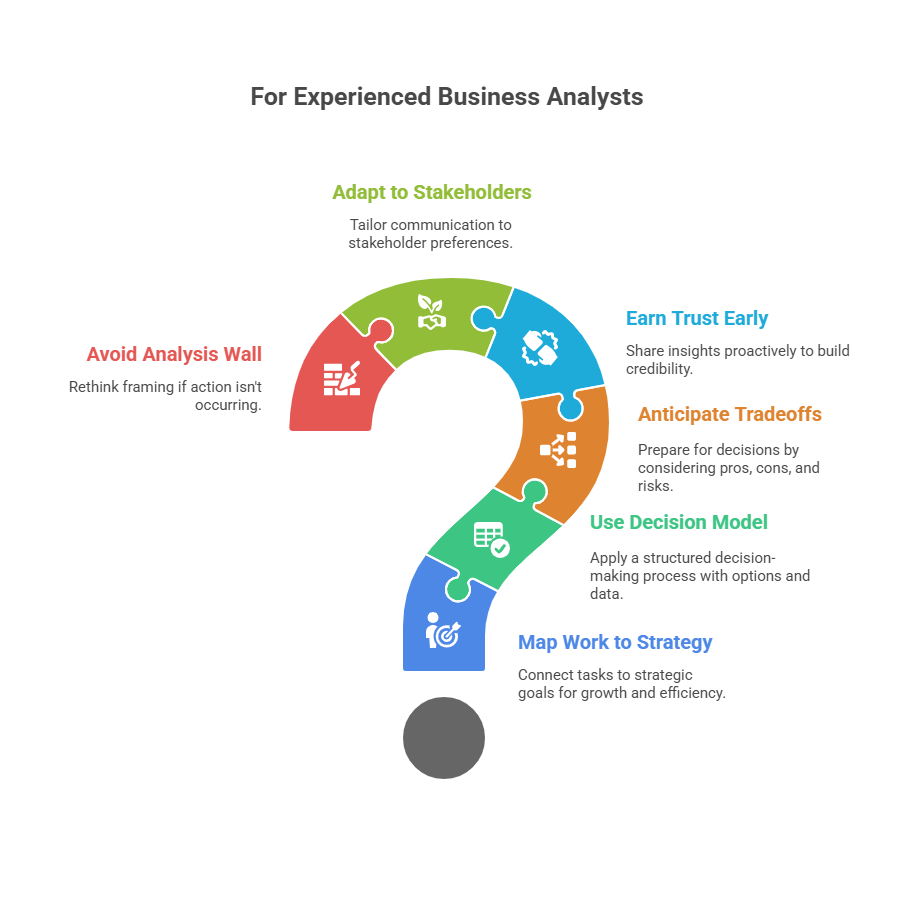Key Takeaways:
- Shift from Tasks to Strategy: BAs gain influence by moving beyond documentation to shaping business direction.
- Speak Executives’ Language: Lead with impact, not detail, to earn attention and trust.
- Connect Work to Goals: Tie analysis directly to strategic priorities using outcomes and KPIs.
- Avoid Influence-Killing Habits: Don’t wait to speak up, over-focus on process, or neglect relationships.
- Earn Trust Over Time: Be proactive, consistent, and clear to become a go-to advisor.
Why Tactical BA Skills Don’t Lead to Influence
A skilled business analyst joins a transformation project with a clear charter, strong technical tools, and engaged leadership. They run workshops, gather requirements, deliver documentation, and meet every deadline. Still, when it’s time for executive decision-making, they aren’t in the room. Why not?
The BA completed their tasks, but they never built influence. Everything was delivered, except a seat at the decision-making table. Many business analysts find themselves stuck at a tactical level. They provide value, but they don’t shape direction. This isn’t a failure of leadership or tools. It’s a missing piece in the process.
By shifting the way they think, communicate, and connect their work to strategy, BAs can grow from project contributors to trusted business advisors. It all starts by understanding what separates the analyst from the advisor.
How Business Analysts Move From Tasks to Strategy
Delivering documentation may check the boxes, but it doesn’t influence outcomes. Analysts who want more impact need to shape conversations, anticipate needs, and show how their work supports business goals.
The analyst mindset is rooted in:
- Gathering requirements and documenting needs
- Ensuring clarity, accuracy, and alignment with scope
- Supporting the delivery of defined solutions
The advisor mindset, by contrast, includes:
- Framing business problems and challenging assumptions
- Proposing high-level options and anticipating risks
- Helping leadership understand tradeoffs and make confident decisions
The Business Analysis Body of Knowledge (BABOK) highlights this shift through its focus on strategy and core competencies. To make that insight land, communication style plays a key role.
Business Analyst Communication: How to Speak So Executives Listen
Executives don’t have time for a 40-page report. Most just want the point before their next meeting and that calendar alert they forgot. They need clear messages that explain impact and guide decisions. To influence that level, BAs must adjust how they communicate. Not by oversimplifying, but by focusing on what matters most to leaders.
Key communication shifts include:
- From detail to impact: “We reduced 14 steps” becomes “We cut onboarding time by 40 percent”
- From tasks to outcomes: “We ran five workshops” becomes “We aligned teams on one customer journey”
- From passive to active voice: “The process was improved” becomes “We implemented the fix”
To present effectively:
- Start with the headline
- Quantify results when possible
- Offer a clear point of view
- Use visuals to support the message
- Know how to speak up confidently in executive meetings
Treat every communication like an executive summary. Keep it short, focused, and structured. Explain what the problem is, why it matters, and what decision is needed. Save the details for an appendix or follow-up slide.
For example:
Instead of, “Our user testing revealed 15 pain points in the checkout process that we documented in a 40-page report,” say, “Customer friction is costing us $2 million annually. Our analysis identified three critical fixes that could recover 60 percent of abandoned carts within 90 days.”
Speaking in a way that resonates with executives builds trust. Once you do that, you can start tying your work directly to the outcomes they care about most.

Connect Your BA Work to Business Strategy
Great analysis still falls flat if it isn’t tied to business strategy. Executives want to see how your work moves the needle on goals like growth, retention, or efficiency. Once you communicate clearly, the next step is showing how your work supports those priorities.
Steps to align your analysis with strategy:
- Know the top 3 to 5 organizational goals
- Map your work directly to one or more of those goals
- Use dashboards and KPIs to show results
- Avoid reporting activity and focus on impact
- Ask: “How does this help the business win?”
If strategic goals aren’t clearly shared, ask leaders about their top three priorities for the quarter or year. Look for recurring themes in company updates, town halls, or board summaries as these often reveal what matters most.
For example:
Instead of saying, “We automated a report,” say, “We saved 12 hours a week across three departments and reduced decision delays.”
Framing your work around enterprise goals builds relevance and respect. It makes your analysis harder to ignore and keeps you visible when leadership makes key business decisions. But to stay influential, you also need to avoid the common habits that quietly undermine credibility.
Common Business Analyst Habits That Kill Executive Influence
Clear messaging and alignment are essential, but they will not help much if your habits are getting in the way. Even experienced analysts can lose influence when they become overly focused on details, wait for direction, or fail to connect with stakeholders.
Common traps to avoid:
- Leading with detail instead of impact
- Waiting for permission to speak up
- Focusing on process instead of outcomes
- Ignoring the importance of organizational relationships
Thought patterns matter just as much as deliverables. Removing these habits creates space to build credibility and relationships that lead to lasting influence.

How Business Analysts Build Executive Trust Over Time
Credibility doesn’t come from a job title. It comes from consistency, presence, and delivering value in ways that others rely on. Over time, trust turns a behind-the-scenes analyst into a go-to voice in high-stakes conversations.
Ways to build that trust:
- Keep your promises
- Admit what you don’t know and follow up
- Stay calm when others panic
- Offer insight before being asked
- Deliver analysis that connects across teams and departments
You’ll know your credibility is growing when:
- You’re invited to strategy sessions
- Executives ask for your input early
- Other departments seek your help
- Your ideas are accepted without a fight
Take for instance how one BA improved customer satisfaction by 25 percent just by being proactive. They spotted a trend in survey data, identified the root cause, and offered three options before anyone asked. Their initiative made them a trusted advisor.
When others see you as a reliable, insightful partner, you will start getting pulled into bigger conversations earlier. That’s when knowing how to navigate organizational dynamics becomes essential.
How Business Analysts Influence Stakeholders
Every organization has its own unwritten rules. Knowing who makes decisions, how influence works, and when to speak up is just as important as having the correct analysis. Strategic influence requires more than logic, it requires awareness.
Understanding the landscape:
- Map power and decision flows
- Identify key influencers, not just formal titles
- Recognize where department goals conflict
Building relationships strategically:
- Partner with allies who support your ideas
- Learn executive preferences and adjust your approach
- Stay neutral and solution-focused
Reading the room:
- Know how your organization reacts to change
- Adjust tone and timing based on the climate
- Understand whether data or relationships drive decisions
To map influence, watch who speaks up in key meetings, who others defer to, and who controls access to resources. Influence isn’t always about title. It often comes from relationships, experience, or simply knowing where the real decisions happen. Sometimes, that’s outside the meeting.
Developing your internal brand:
- Be known as the person who “sees around corners”
- Help others connect operational work to strategy
- Become a reliable voice in tough conversations
Understanding the people and the power structures around you helps make sure your ideas don’t get lost. When your insights reach the right audience, you’re better positioned to influence outcomes and support cross-functional alignment.
Help Executives Make Better Decisions as a Business Analyst
Once you’ve earned a seat at the table, your value comes from helping leaders act with confidence. Executive decisions happen quickly, and they require clarity. The better you are at framing decisions and surfacing tradeoffs, the more leaders will rely on your input.
Provide an executive summary in decision form that contains:
- A clear summary of the decision
- Key options with risks and tradeoffs
- Trusted data
- A well-reasoned recommendation
Using this framework:
- What is the decision?
- What are the options?
- What does the data show?
- What do you recommend and why?
Sometimes leaders will disagree on priorities or preferred outcomes. Your job isn’t to settle the disagreement. The goal is to lay out the facts clearly so they can weigh the tradeoffs. Always clarify which data supports which option, and explain the risks involved in choosing one path over another.
Example:
“Decision: Choose our onboarding platform. Options: Build ($500K, 8 months), Buy A ($200K, 2 months), Buy B ($150K, 3 months). Data shows A has the best adoption rate. I recommend A for a 4x ROI and fast Q4 launch.”
Good decision framing positions you as a problem-solver who saves time and prevents missteps. That kind of value earns trust, but it can quickly fade if you fall into habits that undercut your influence.
How to Become the Strategic BA Executives Rely On
Influence isn’t earned through job descriptions. It’s earned by shifting your perspective, framing your insights with intention, and showing that your analysis supports big-picture business outcomes. That’s how analysts become advisors.
Start now by reworking just one project update. Focus on explaining the issue, why it matters to the business, and what needs to happen next. Lead with insight. Speak with clarity. Deliver value that leaders can use.
When your team is ready to grow from tactical execution to strategic influence, Watermark Learning can help. Our expert-led training equips business analysts with the communication, leadership, and advisory skills needed to influence at the highest level.
Unlock your team’s potential with Watermark Learning.
Jay Pugh, PhD
Dr. Jay Pugh is an award-winning leader, author, and facilitator with over 18 years of teaching and training experience. Currently serving as Head of Leadership Growth at Educate 360, he leads a robust team of external and internal facilitators who specialize in developing leadership capabilities within medium and large-scale businesses. His team works directly with business professionals, helping them become more effective leaders in their daily operations.
Dr. Pugh holds a Ph.D. in Instructional Management and Leadership, and his academic contributions include two published articles and a dissertation focusing on various educational topics. His extensive experience and academic background have established him as a respected voice in leadership development and educational management.

 New Horizons
New Horizons
 Project Management Academy
Project Management Academy
 Six Sigma Online
Six Sigma Online
 Velopi
Velopi
 Watermark Learning
Watermark Learning
 Login
Login





 New Horizons
New Horizons
 Project Management Academy
Project Management Academy
 Velopi
Velopi
 Six Sigma Online
Six Sigma Online
 Watermark Learning
Watermark Learning